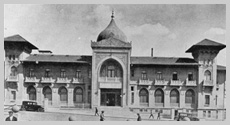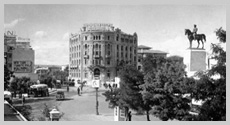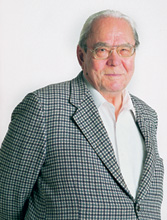 This week Prof. Halil İnalcık, founder of the Department of History, and an expert on classical Ottoman history shares with Bilkent News his thoughts about Turkey's capital city, Ankara. This week Prof. Halil İnalcık, founder of the Department of History, and an expert on classical Ottoman history shares with Bilkent News his thoughts about Turkey's capital city, Ankara.
Prof. İnalcık has lived in Ankara for 80 years, and has much to say about the city's people, culture and overall ambiance. Here he reflects on the past several decades of life in Ankara.
The Ankara Years, 1925-2009
I came to Ankara in 1925 with my family and have since then spent most of my life here. I have witnessed 80 years of history in the making and personally experienced all of Atatürk's reforms.
I remember I was in fourth grade when I was chosen to read a speech during the unveiling of the Atatürk statue in Ulus Square.
I eventually finished my primary education at the school with the same name of Atatürk. I still remember throwing away my fur cap (kalpak) during the headgear reform. Before the adoption of the new Turkish alphabet, we were studying the old alphabet in primary school, and the morning lessons started with fatiha.
Back in 1925, when I first arrived in Ankara it was really difficult to find a house. The best places to live were in the Jewish District and Ankara Castle, where Turkish businessmen and other well-off people lived inside old mansions within the castle.
 The business center of modern Ankara was centered around the Ulus Square. Taşhan, banks, Karpiç (restaurant), cinemas were all around that square. At that time three main streets made up Ulus Square: İstasyon Street, which holds the Grand National Assembly of Turkey and Ankara Palace; Çankaya Street, the modern avenue which leads to Atatürk Köşkü and is home to all the embassies. Samanpazarı was the old commercial center of Ankara, but because of the fires there were very few things left from that marketplace. There was practically no life beyond these streets. It was estimated that the population of Ankara was approximately 30-40 thousand when I first arrived. The business center of modern Ankara was centered around the Ulus Square. Taşhan, banks, Karpiç (restaurant), cinemas were all around that square. At that time three main streets made up Ulus Square: İstasyon Street, which holds the Grand National Assembly of Turkey and Ankara Palace; Çankaya Street, the modern avenue which leads to Atatürk Köşkü and is home to all the embassies. Samanpazarı was the old commercial center of Ankara, but because of the fires there were very few things left from that marketplace. There was practically no life beyond these streets. It was estimated that the population of Ankara was approximately 30-40 thousand when I first arrived.
But all that was soon to change. Ata put outstanding importance on the construction of a modern city. İş Bank, Ziraat Bank, Gazi Statue at the hill, the culture center Etnografya Museum, and the Vakıf Building, which were built in Mimar Kemal style, were the most important architectural projects of that time. After that German architects and engineers brought European architecture to Ankara in the 1930's by their Bakanlıklar and the Faculty of Language, History and Geography (DTC Fakültesi) projects.
Turks lived like a single family under Atatürk's leadership. His arrivals and departures to and from Ankara were always marked in our calendars. We all were excited when he visited our faculty. And then came 1938 and his illness. His body was brought to Ankara from İstanbul, in front of the Grand National Assembly at the catafalque, where all the Turkish people walked in mourning for days. Everybody from the whole world, delegations, commanders, bowed before his casket. You have to see, how one nation can burst into tears.
 Ankara has since then developed with its considerable scientific institutions. The Faculty of Law has been the core of Ankara University since 1926. The work of the School of Agriculture (Ziraat Mektebi) and later the Faculty of Agriculture, was fundamental to advances in Turkish agriculture and livestock production. German experts were the first professors of the faculty. Numune Hastanesi, Faculty of Language, History and Geography in 1935 awaken with the activities of the German professors who escaped from the Hitler regime. (Prof. İhsan Doğramacı in his early years worked as an assistant of one of the German doctors, whose name was Prof. Albert Eckstein.) Ankara has since then developed with its considerable scientific institutions. The Faculty of Law has been the core of Ankara University since 1926. The work of the School of Agriculture (Ziraat Mektebi) and later the Faculty of Agriculture, was fundamental to advances in Turkish agriculture and livestock production. German experts were the first professors of the faculty. Numune Hastanesi, Faculty of Language, History and Geography in 1935 awaken with the activities of the German professors who escaped from the Hitler regime. (Prof. İhsan Doğramacı in his early years worked as an assistant of one of the German doctors, whose name was Prof. Albert Eckstein.)
I heard a joke being told among the deputies of The Grand National Assembly of Turkey, from Yahya Kemal: "Ankara is alluring because there is hope of a return to İstanbul from there," but this joke doesn't carry the same weight anymore.
Ankara's transformation into a metropolis with a population of three million shows us Turkey's development. Turkey with 15 million people became 70 million in 2000. Even in areas far from the city core, new district-cities and satellite areas grew around the city proper. Bilkent is one of them, with its university filling Ankara with a vibrant youth culture. The metropolitan Municipality of Ankara, by pursuing technological innovations, has contributed to the field of electrical service and road networks. In 2000 Ankara joined the club of modern metropolises in the world. 
|







